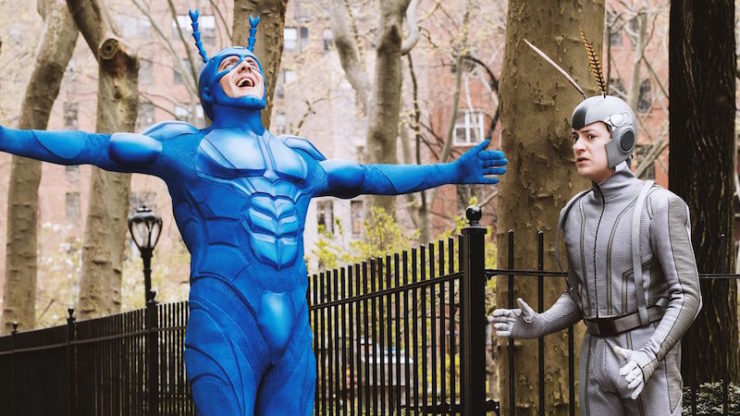Mental illness doesn’t go away. While it has finally become more common to discuss mental illness publicly, as people join in awareness days and campaigns on twitter, it’s still rare to see an honest, realistic portrayal of mental illness in pop culture, something which may stem from the fact that it isn’t “fixable.” Like chronic pain, mental illnesses can be treatable and manageable, but they also tend to be a permanent part of a person’s life in a way that Hollywood, with its love of neat endings, doesn’t often depict. Instead we get the version of illness seen in Girl Interrupted, Benny & Joon, Silver Linings Playbook—eruptions of emotion, hallucinations, and suicide attempts. Some television shows are doing a better job: Bojack Horseman’s exploration of depression; You’re The Worst’s insistence that romantic love can’t “fix” mental issues; Crazy Ex-Girlfriend’s realistic treatment of anxiety balanced with the lightening effects of musical numbers.
Two current shows (possibly my favorites on TV right now), are handling mental illness in really interesting ways, especially since neither inherently demands a focus on mental health issues. Dirk Gently’s Holistic Detective Agency is a wacky detective show that bounces between sci-fi and fantasy tropes, while The Tick is an update on a thirty-year-old superhero parody. But in both cases the writers are highlighting issues of mental health in subtle, sensitive ways that illuminate the reality of living with those conditions, without vilifying them or making the characters seem tragic, and in both cases that choice has added depth and heart to shows that could have been silly.
In Season One of Dirk Gently, we’re introduced to Todd and Amanda Brotzman. Amanda suffers from a chronic illness called pararibulitis, which runs in the family. By the second season, Todd has it too. This fictional disease works so well because Landis and his writers have imbued it with very real elements from chronic pain and anxiety conditions—basically, you hallucinate something terrible, like that you’re on fire or have a knife stuck through your hand, and your brain thinks the hallucination is real, so you experience the same pain that you would if the event was “really” happening. Pararibulitis attacks can strike out of nowhere, or be triggered by extreme stress, and they’re difficult to stop. In season one, the disease has completely taken over Amanda’s life. She lives as a prisoner inside her home, afraid that an attack in public might lead to something even worse.
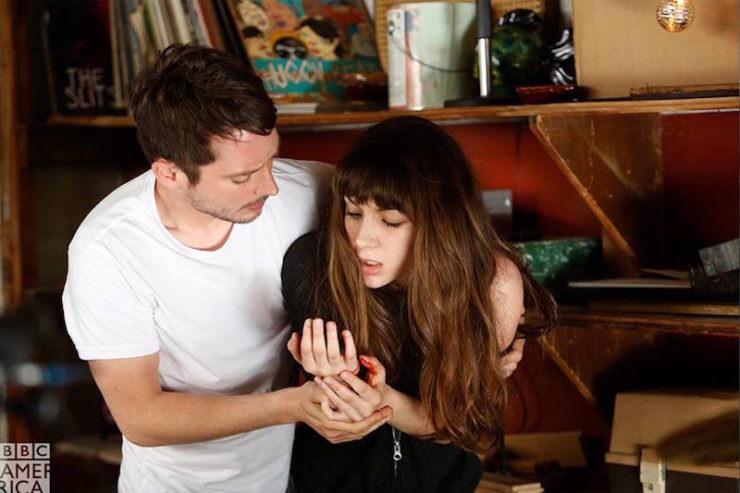
When we pick up with Todd in season two, we see that his attacks can come at any time, but for reasons I won’t spoil, he doesn’t have the option of hiding at all. When an attack hits him on a public highway he has no choice but to collapse, in full view of a police officer, and utterly lose control of his body to an invisible attack, as the cop stands there completely baffled. The scene drives home the idea that Todd and Amanda have no control over their attacks, and it’s terrifying when they hit. It isn’t just that the attacks themselves are excruciating, they also disrupt their lives, makes it impossible to hold down a regular job, make plans with friends, stick to a schedule—in short, pararibulitis renders them them helpless, because the disease doesn’t care if you’re trying to get your life back together, or if you just need to run a quick errand. It doesn’t care if you’re happy because you’ve made a new friend, or you’ve managed not to have a drink for two whole weeks. If it hits, everything else in your life stops while you deal with it. Everything else in your support networks’ lives stops, while they help you deal with it. That’s the echoing truth surrounding each Facebook post about mental health, every retweet about depression: like any illness, mental illness forces you to deal with it.
This is balanced perfectly with Farah Black’s issues. When we meet Farah, she’s being held hostage and initially hollers for help, but she quickly frees herself and spends the rest of season one being a total badass… most of the time.

Because Farah is also wracked by anxiety. She’s smart, strong, capable, and well-trained. Her father runs security for a millionaire, and she has not only grown up learning from him, but also trained in combat with the intention of joining the FBI. But then she choked. And she continues to choke, in what becomes a mirror for the pararibulitis attacks Amanda and Todd suffer from. When her brain gets ahead of itself, she second-guesses her actions, distrusts herself, and, in some scenes, literally walks in tight circles arguing with herself. It’s a perfect physical expression of the sort of death spiral plenty of people with anxiety issues get: even though you know you’re smart and competent, you can’t trust your own thoughts, which then leads to you beating yourself up, because aren’t you supposed to be smarter than this? Better than this?
As with Amanda and Todd, support from friends can help, but there isn’t a cure for anxiety, it’s just a thing that you have to manage. I’ve been very happy that Season Two Farah is still anxious, but is also getting a bit better at working through it—the show so far has struck a fine balance between showing her strength and being realistic about her ongoing struggle. She’s able to stand up to her jerk of a brother, but she also feels the need to arrange a police officers pens by size and color because she needs to be in control of something.
It’s that delicate tapdance that my other favorite show, The Tick, does maybe even slightly better.
In the (classic, perfect, epoch-defining) ’90s cartoon, Arthur is a stock character. A pudgy, oft-terrified accountant, his biggest aspiration is to be a sidekick—not as anything big or threatening, but as a moth, and even then he’s constantly mistaken for a bunny. The Tick sleeps on his couch, but Arthur doesn’t really provide much during their fights. His battle cry isn’t the surrealist cry of SPOOOON, but the pathetically literal plea: “Not in the face!”
In the early 2000s live-action reboot, the opening of the show is from Arthur’s point-of-view, and we see that he has a dream to become a superhero…but that’s it. We don’t really know why he chooses to don a suit and head to the roof, other than a general desire to change his life. It’s not quite a mid-life crisis, but it’s not quite not that, either.
I was initially unsure of another live-action reboot of The Tick. I loved the 2001 series, but in a world now saturated with superheroes, did we really need more? But the way the current series has fleshed out Arthur is not only interesting in its own right, it also builds on the previous versions of the character while using him to give us a type of hero I don’t think we’ve ever seen on TV before. The first time we see Arthur Everest he’s buying milk. He’s in a bodega, and the TV is playing an interview between Whoopi Goldberg and the world’s first superhero, Superian. The two are discussing The Terror, an infamous supervillain, whom Superian killed in battle back in 1998. Whoopi and Superian agree, while laughing, that anyone who thinks The Terror is still alive must be “cray.”

Arthur buys his milk and goes home, but he doesn’t stay long—he has to dash off to the warehouse district to stake out a nefarious operation. it’s part of his campaign to prove that the worlds worst supervillain is still alive. He’s one of the cray ones, you see. Of course he gets caught and dragged in to the police station, and here’s where the show turns. A therapist assesses Arthur to see if he needs to be put on a 72-hour hold, and asks if he’s been taking his meds. He replies with annoyance, muttering “Yeah,” before she gives him a stern look—the look of an adult chastising a child. “Yes?” she asks. He straightens up, and his “Yes” is clearer and contrite. She has all the power here, and he is at her mercy. She then looks over his list of prescriptions, drops all professional facade, and says, “…wow.” And as she reads the meds off to him he squirms, folds into himself, avoids eye contact. Never mind that these are prescriptions to help a medical condition, he is being made to feel shame for needing them. He is being humiliated for not being healthy. She reads them off to him, because she has to confirm that he’s taking both of them: Amisulpride and Celecoxib—which are real drugs.
Which means, citizens, that we have a diagnosis.
When does this happen on TV? When does this happen on TV, and then the diagnosed person goes on to become a hero? This isn’t Sherlock or Sheldon or Bones, with their kinda-sorta Aspergers Syndrome, or Hannah Horvath with her on-again-off-again OCD. Arthur is taking real medication, specifically an anti-psychotic used for the treatment of schizophrenia, and a non-steroidal anti-inflammatory drug used to treat severe depression, bipolar disorder, and, also, schizophrenia. Celecoxib is available in the U.S., but Amisulpride isn’t used here yet, implying that The Tick is happening in a universe not quite out own, while also taking the time to commit to a particular type of medication. Oh, in case you thought that “buying milk” was just random filler for a scene? A major side effect for Amisulpride is male lactation.
Because Ben Edlund is a fucking god among writers.
Griffin Newman plays the scene perfectly: pissed, surly, scared—they can legally hold him for 72 hours, there is nothing he can do about it, no authority he can appeal to. They can fuck up his job, his life, his relationship with his family. One little slip, made for all the right reasons, and years of progress goes out the window like a superhero running up to a roof. Plus, part of him is worried that he actually is slipping—which is the other thing with a mental illness. How can you trust anything when you can’t trust your own mind? What if he does start to go down dark paths again, and doesn’t realize it until it’s too late?
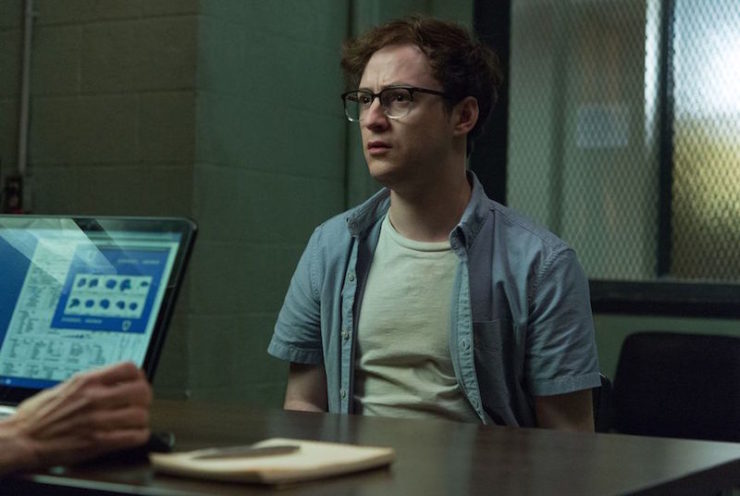
Then the therapist realizes who Arthur is: “Oh. My god. You’re the little boy from the photograph.”
He flinches away even more, looking away so he won’t have to see her pity, and we’re led into a flashback. The Terror has blinded The Flag 5 (Young Arthur’s favorite superhero team) and they’ve crashed their jet…right on top of Arthur’s father. The Terror murders the Flag 5, not even noticing the collateral damage of Arthur’s dad, and then walks straight up to the little boy and eats the last of his ice cream sundae.
Arthur’s traumatic event wasn’t a villain killing his parents or uncle—it’s his favorite superhero team, people he idolized, killing his dad by accident. His dad becomes collateral damage, a footnote to the day the Flag 5 were felled by the Terror, who in turn was vanquished by Superian a few months later. Arthur isn’t famous for donning a suit and becoming a vigilante hero, he’s famous for being a terrified little boy. He doesn’t react by training in a cave or becoming a ninja, he reacts by losing control of his mind.
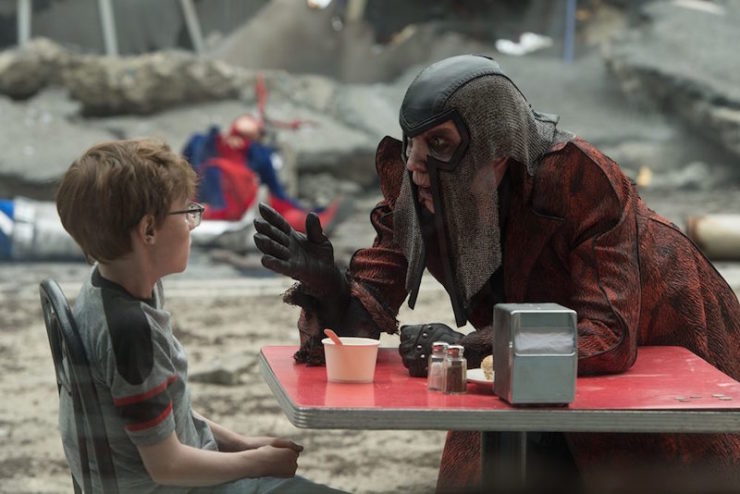
Back in the present, the therapist calls Arthur a “poor broken man” and agrees to send him home.
Did I mention that this whole conversation takes place under the watchful eye of a police officer? Because it has to, in case Arthur gets violent and attacks the therapist, but since we know Arthur is correct, and since, again, Newman plays the scene as a scared kid, the police presence only seems like a threat against him, never protection for the doctor. And when Arthur tries again to plead his case, the cop drops his façade of pity: “Hey, asshole, where you want to spend your weekend?”
And then Dot picks him up. When he tries to tell her about his theory that The Terror is back at work, her response will be familiar to anyone who’s been part of a support network like this:
Dot: We’re going to go through all this again.
Arthur: I saw one of his enforcers, there, tonight.
Dot: Well but Arthur you see things, remember?
Arthur: This wasn’t…that.
Dot: No weird visions? No voices?
The show then spends the entire next episode lampshading the idea that Tick is a hallucination. He keeps disappearing when Arthur’s around other people, he believes Arthur’s theories when no one else does, plus, tragically, he makes Arthur feel happy. Arthur doesn’t consider “happy” to be “normal.
Arthur does a classic Sixth Sense-style montage, remembering all the times he’s interacted with Tick, and decides that he must be hallucinating. (This was distressing to me, because if you don’t mind me getting personal for a sec, I need the Tick to be real. In a fictional sense.) This scene is set to a slowed-down version of “Where Is My Mind,” in an episode titled “Where is My Mind,” and the obvious Fight Club riffs are hilarious, but since Arthur’s panic is visceral and utterly real, it undercuts the silliness. Your first instinct is to laugh at the reference, but here’s this poor broken man freaking out in front of you. When Arthur reaches Dot, she’s also upset because he’s been ignoring his phone (he’s been preoccupied by the Tick) and seeing him wearing a blue poncho on a sunny day doesn’t help.
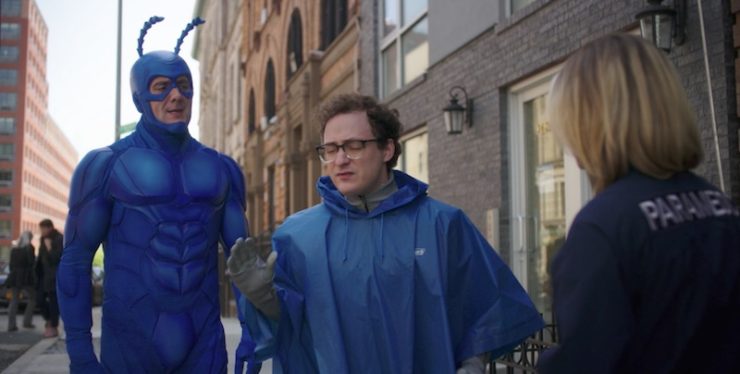
She asks him to repeat “the drill” with her: “Normal is what normal does: takes meds, returns calls, dresses appropriately for the weather.”
They have a pattern together, a mantra, to keep Arthur tethered to reality. When he says that the normal thing isn’t working right now, she moves to calm him with the practiced air of someone who has done this dozens of times: “You’re having a bout of paranoia, right on schedule. Just like last time, remember?”
Which again, this is how this type of illness works—many mental illnesses are cyclical, and a person who’s been doing fine for weeks might hit a rough patch and need to go back to the hospital or adjust their medication while they recalibrate. What’s pitch perfect is that Dot, who last episode was a bit harsh with Arthur, is simply concerned and soothing now that she sees his desperation. But then a moment later she sees the Tick, and Arthur realizes that while he may be slipping, at least he’s not hallucinating a giant blue superhero.
This is such a giant step forward for the world of The Tick that I had to pause the episode at that point and catch my breath. In the original, 2001 live action iteration, Arthur’s sister and mother swoop in and have him committed to an asylum in the episode “Arthur, Interrupted.” It’s later revealed that they have fallen under the sway of Francis Peacock (a freaking terrifying Dave Foley) a Wertham-esque psychologist who thinks that superheroes are all sick people in need of therapy. Part of the way through the episode it’s revealed that Peacock is dressing up in confiscated costumes. Arthur is released, and it’s implied that he may never truly forgive his sister. It’s a deeply uncomfortable episode, because it presents the worst-case scenario of mental health—that a person will be thrown in a Bedlam-style hospital and abandoned.
The new version of the show, I’m assuming quite consciously, takes this episode and unpacks it piece by piece. Yes, Dot is the voice of “reason,” but she’s also a real person, with her own life, not just a caricature. Yes Arthur has been in therapy and is on medication, just like a lot of other people. Yes he’s traumatized, but he is also as the show continues, proved right. Both of these things can be true—he can be emotionally fragile and also correct that The Terror is still alive.
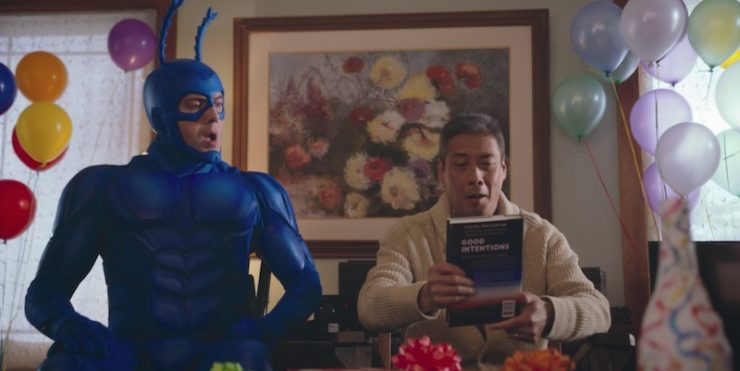
The next episode only confirms this. Arthur, trying to hold onto normal, goes to his stepfather Walter’s birthday party. His mother asks how he is, and asks, not only if he wants to talk, but if he wants her to get him someone to talk to. Then she points out his old therapist, Dr. Paul, and “Dr. Biosco, the outpatient psychotherapist during your little sophomore break” who have both been invited to the party. She tells him she can schedule something. Rather than handwringing or trying to hide his illness, his mother confronts it, offer to help, but also offers people who are professionally trained to help. This isn’t done in a hushed way, or in a way that puts Arthur on the spot, it’s just an offer of support. When he goes in to see Walter (played by The Expanse’s François Chau, and a delight every moment he’s onscreen) his step-father refers to it as “choppy surf, mentally speaking.”
Walter, too, offers to listen, but goes further, assuring Arthur that he really wants to know how he’s doing. There’s no snark here, or caustic one-liners—despite The Tick being a (hilarious) comedy, Arthur’s health is treated seriously.
Finally, when he chides Dot for telling their mom, she recites: “Full transparency; zero enabling; normal is what normal does, right?”
He nods and replies, “Normal is what normal does.” Then in a brilliant move, he opens a beer while keeping his thumb firmly in place over the cap—high-strung Arthur can’t handle it flying off too quickly—and then pockets the cap.
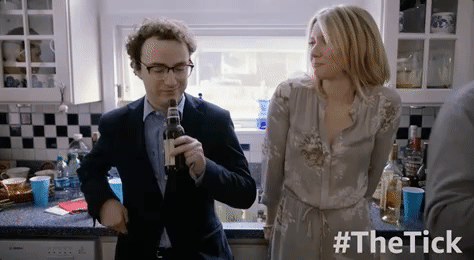
Now, I know I keep harping on this, but here we have the hero of the story agreeing that his family is correct to keep an eye on his mental health. There’s no bullshit connection between mental anguish and genius or heroism on this show. Arthur’s not “the smartest guy in the room.” But he is the hero. He’s the one who kept connecting the clues to discover that the Terror is alive, and he’s the one who puts himself in danger to protect others from his evil plot. It’s a real risk for him—he’s not nigh-invulnerable like his giant blue friend—but it’s a risk he knows he has to take. He becomes a hero and submits to what the Tick calls his “destiny,” but he also takes his meds. He sees superheroes because they’re real in his universe, and ferrets out conspiracy because villains are literally conspiring against humanity, but he still has to be accountable to his family, show up for parties, check in with Dot—because they love him, and they want him to be healthy.
Both The Tick and Dirk Gently have made a revolutionary choice to treat mental illness as, well, just another illness. It can be diagnosed, treated, and lived with, just as a person can live with endometriosis, or lupus, or Crohn’s disease, or any other physical illness. And while having these conditions doesn’t automatically make you a super genius, both shows have taken the step of giving characters who would be described as “nuts” or “loony” the heroic arcs, and given them center stage. All this in shows that could have easily just been fun, wacky comedies, but choose instead to create empathetic portraits of people struggling with illnesses that until recently were considered shameful secrets.
The first half of The Tick’s first season is available on Amazon Prime (and the second half will premiere on 2/23/18), and Dirk Gently’s Holistic Detective Agency airs on BBC America, Saturday nights at 9:00pm.
Leah Schnelbach has never been happier about a televisual trend! Come talk to her on Twitter.










